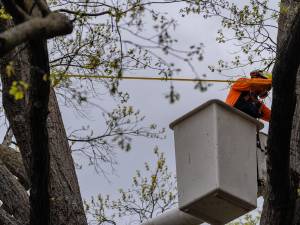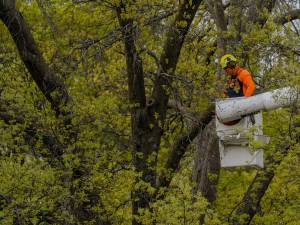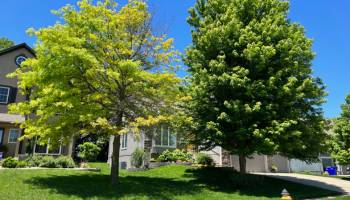Our Tree Support Systems
In Liberty, Parkville, Riverside, North Kansas City, and Smithville, tree support systems, such as cabling and bracing, are vital for maintaining the health and safety of trees. These systems provide additional support to weak branches or compromised stem unions, reducing their potential to break or split under stress.
Cabling can be applied independently, but bracing is often used in conjunction with cabling for added reinforcement. At Arbor Masters, we adhere to ANSI A300 standards for the type and size of hardware used in our tree support systems.
Cabling

Bracing


Why Choose Arbor Masters for Cabling and Bracing in the Northland
When it comes to tree cabling and bracing, Arbor Masters is the trusted choice. Here's why:
Our Cabling and Bracing Process
Many people are unaware that they can add structural support to their trees. At Arbor Masters, we have been perfecting our craft since 1960, so you can rest assured that your trees are in the best possible hands.
Here's what you can expect when you hire us for cabling and bracing:

Initial Consultation
Our arborists will conduct a thorough inspection of your trees to assess their condition and determine the appropriate support systems. We will also discuss your goals for your trees and your budget.
Provide a Quote
Based on our assessment, we will provide you with a detailed quote outlining the scope of work, materials, and estimated costs. We will also be happy to answer any questions you have about the process.
Plan and Prepare
Our team will finalize a detailed plan for installing cabling and bracing systems to ensure the most effective solution for your tree.
Install Support Systems
Our skilled arborists will carefully install the cabling and bracing systems, ensuring they are securely attached to your trees and provide the necessary support. We will also clean up the work site and dispose of any debris.

Signs Your Tree Needs Cabling and Bracing
Cabling and bracing are designed to support trees with weak or compromised structures. If you notice any of the following signs, it may indicate that your tree needs a little extra support:
Cracks or Splits in the Trunk or Branches: These can be caused by stress, disease, or decay.
Leaning or Tilting Trees: A tree that is leaning or tilting may be unstable and at risk of falling.
Weak or Broken Branches: Weak or broken branches can be a sign of structural problems within the tree.
Co-dominant Stem Unions: When two or more main stems grow from the same point on the trunk, it can create a weak point that is susceptible to failure.
Large, Heavy Branches: Trees with large, heavy branches are more likely to experience stress and breakage.
Storm Damage: Trees that have been damaged by storms may need cabling and bracing to prevent further damage.
Signs of Disease or Decay: Trees that are infected with diseases or decay are more likely to have weakened branches and trunks.
Supporting Trees Near You in Parkville, Liberty, North Kansas City & Beyond
Although our office is located in Parkville, MO, we also serve several other communities throughout Kansas City's Northland, including:
Northmoor
Gladstone
Ferrelview
Weatherby Lake
Parkdale
Tree Cabling & Bracing FAQs
Trees should be inspected annually by a qualified arborist. Regular inspections can help identify potential problems early on and prevent more serious issues from developing. Factors such as the tree's age, species, location, and any recent storm damage can influence the frequency of inspections.
How long tree support systems can last depends on several factors, including:
- Materials Used: High-quality materials, such as stainless steel or galvanized steel, can last longer than lower-quality options.
- Tree Health: A healthy tree can better support the cabling and bracing system, extending its lifespan.
- Environmental Conditions: Harsh weather, such as storms and extreme temperatures, can accelerate the deterioration of cabling and bracing systems.
With proper maintenance, tree cabling and bracing can last for many years. Regular inspections and adjustments are essential to ensure the systems remain effective and safe.
Yes, tree support systems can be done on most types of trees. However, the specific techniques and materials used may vary depending on the tree's species, size, and the nature of the problem.
A Certified Arborist can assess your tree’s unique needs and recommend the most appropriate support system.
While tree cabling and bracing can be visually noticeable, they are designed to provide structural support and are not typically installed with the primary goal of blending in with the tree's appearance.
The placement of cables and braces is determined by specific engineering principles to ensure maximum effectiveness. However, due to their elevated position in the tree canopy, cables are often less conspicuous and usually hard to see.

